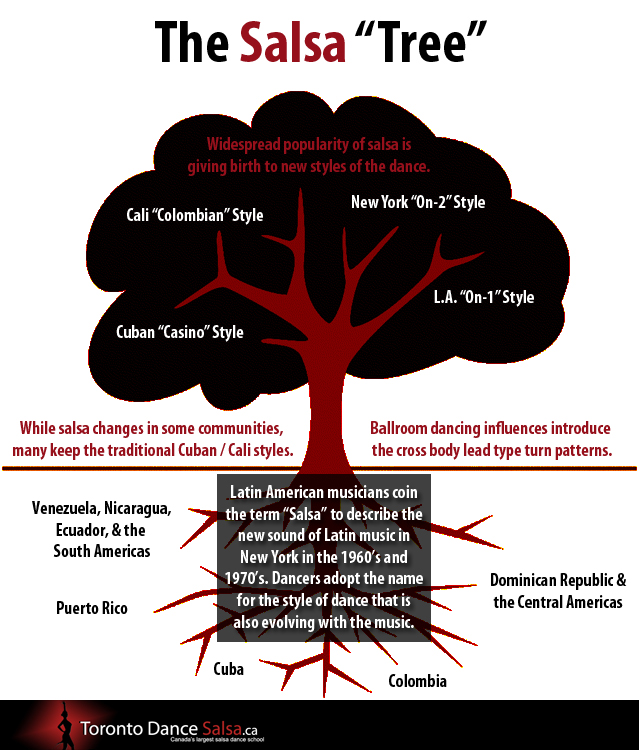Some Known Incorrect Statements About Dance Fridays
Table of ContentsSome Known Factual Statements About Dance Fridays Everything about Dance FridaysHow Dance Fridays can Save You Time, Stress, and Money.The Best Strategy To Use For Dance Fridays
Allow's think about Salsa dancing and songs as a large Tree that appears like this: Salsa is danced globally while several technological aspects of the dancing are the exact same across styles (6 steps over 8 beats danced on a quick-quick-slow or slow-quick-quick rhythm), there are a number of "trademark" attributes of the primary styles of Salsa that identify one from the other.Couples taking part in a Casino site Rueda dance all relocate unison as called by a Leader. Distinguishing attributes of Cuban style salsa are circular turn patterns (with "break back" actions on counts 1 and 5) along with body language motivated by typical Afro-Cuban folkloric dancings. Distinguishing functions of Cali design salsa is fast and detailed footwork, danced with a strong hand hold connection in between partners.
The origins of the design are a topic of discussion, yet it is stated that New York style Salsa dance came from the 1960's because of the influx of Latin American emigrants after the Cuban Transformation. Eddie Torres is one of the most popular New york city style dancer, being almost widely credited with popularizing the design to dance centres outside of New york city.
The standard rhythm of "On-2" is slow-quick-quick. The "youngest" of the styles of Salsa, L.A. Style (some people have actually called it "West Shore" style) ended up being popular in the 1990's and has its beginnings in ballroom (Mambo, Swing and Cha, Cha, Cha). Transform patterns lead and adhere to strategies are heavily influenced by these designs, with the Cross Body Lead being the keystone of the style.
Little Known Questions About Dance Fridays.
Design are execution of turn patterns and figures in the "port", with the break steps on counts "1" and "5". This style is likewise characterized by expensive and commonly intricate arm designing by the follow to accent the "1" and "5" matters. The standard rhythm of "On-1" is quick-quick-slow. While Salsa songs has strong origins in Cuban, Colombian and Puerto-Rican folkoric practices, it can not be marked down that all Afro-Latin and Latin American societies have added to contemporary Salsa songs as we recognize it today.
It's possible that due to political reasons the contribution of Afro-Cuban culture and heritage to modern Salsa in the 1960's and 70's is not widely identified, but it can not be overlooked the massive contribution and influence of the "Queen of Salsa", Celia Cruz (salsa club san francisco). Thanks to the internet and simplicity of accessibility to details, the appeal of Salsa music, dancing and culture has actually spread out like wildfire over the last 30 years and also then contemporary Salsa musicians continue to pay tribute to the Starting Dads and Mommy of Salsa.
Today Salsa songs is created, performed and renowned worldwide. In 2000 the impact of Latin American songs and society (not simply Salsa) was acknowledged by the National Academy of Recording Arts and Sciences in the United State and the Latin Grammy Honors were produced. The Latin Grammy's have actually brought focus to the Salsa Legends and contemporary Salsa musicians alike
The Main Principles Of Dance Fridays
identifying features of Salsa songs are: 4/4 time trademark, Child Clave and Tumbao rhythms, Montuno Piano Unless you have a history in music, the above 3 qualities probably imply absolutely nothing to you. A less complicated way to describe Salsa music is just how it does NOT seem like various other sorts of Latin American music.
Bachata is a straight 4 beat dance with a prevalence of a syncopated guitara line and a clear lack of any type of "difficult" piano, brass (trumpet, trombone) lines. Cha, Cha, Cha appears like Salsa songs the most as it feels like "actually slow" salsa/mambo. salsa club san francisco. Cha, Cha, Cha can be identified by it's emphasis of the double tumbao beat on counts 4 +5 and 8 +1 (the "cha-cha-cha") You've been to a Salsa evening at a club and you're hooked you like the music, the power, the look of two professional dancers gliding throughout the dancing floor carrying out awesome spins and transform patterns
A lot of brand name new professional dancers choose to find out L.A. "On-1" style slotted Salsa designs are the most prevalent in North America (with some exceptions of some metropolitan centres that still mainly welcome Cuban and Puerto Rican styles) and L.A
Dance Fridays Things To Know Before You Buy
L.A. Style will quickly teach you show fundamentals of Basics timing, weight transfer and turn pattern execution. Many dancers, when they've had a year or two of dance L.A. Design Salsa under their belts, "button" to New York design in order to diversify their dance vocabulary; yet many dancers decide to stick to just one design of Salsa and enjoy their time on the dancing flooring in that specific design.
Style and New York City Design all being danced in the very same club, with most of the professional dancers having the ability to change from one design to the other from one track to the next. No issue which design you select it is essential to stay with that design until you're very comfy with the fundamentals of timing, body rhythm and foundation move execution before thinking about "changing" styles (if you weblink wish to).
